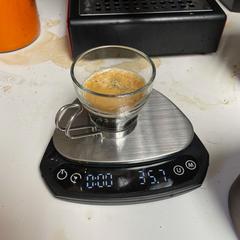Gusto Decaf Polifemo
When I ordered a bunch of ESE pods for this ongoing ESE pod experiment, PODhead sent me a few samples of a few other pods. This is one of them. Oddly, I couldn’t find this particular one anywhere on their website, although a websearch turned it up, so it’s probably just something weird about their site navigation.
Also, given some of the extraneous slug text on the link, I worry about whether the links will remain active in the long term as their stock changes. If anyone from PODhead wants to let me know about what’s going on with that, it’d be greatly appreciated!
Anyway, they only gave me two pods, so I can only do a two-shot evaluation. For my first shot I went with a lungo, which I managed to get exactly 21g out. Yay me! The shot pulled cleanly and there was no channeling. Some slight bitter notes, maybe a little bit burned, but nothing unpleasant. Good texture. Left behind some sweet notes on my palate.
For my second shot I opted to go with a standard shot, and got 15g out. Just like with the Cremissimo arabica decaf I paradoxically got something more bitter and overextracted. So, this stuff definitely wants a shot on the longer side. It was still decently drinkable though.
This seems like a decent starter espresso for someone who just wants something simple and no-nonsense, and is somewhat forgiving to overextraction. Someone who doesn’t care about the fiddly details of espresso, or extraction ratios or channeling or texture, someone who has never heard of WDT or calibrated tamping or puck prep or any of the debates about 3 bar vs. 9 bar vs. 15 bar.
I used to be like that.
Sometimes I miss those days.
This coffee is fine.
